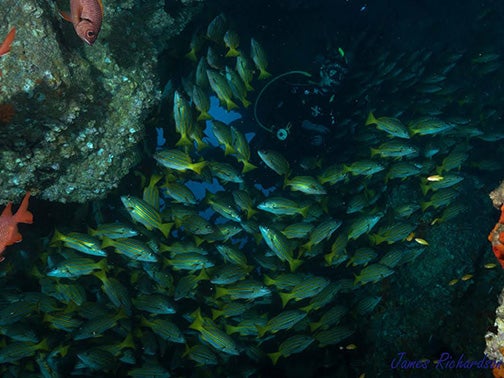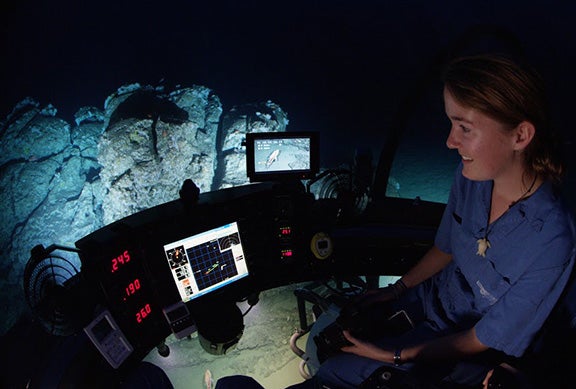KINGSTON, R.I.- January 30, 2018- From a young age, Callie Veelenturf had no desire to be a “girly girl.” It could have been her dislike of the color pink or her strong desire to be outdoors spending her days chasing frogs, catching snakes and observing turtles on her grandparents’ farm in Harmony, Maine.
When asked what she wanted to be when she grew up, as a child her response was always the same, “I want to save the animals.” Fast forward to her final year of high school in 2010 during an immersive environmental education program in Hawaii when Veelenturf found herself face-to-fin with a massive green sea turtle. While most people would be terrified of a 300-400 pound marine animal, she stared directly into its eyes and made a silent promise to spend her life conserving marine wildlife.
Her experiences, paired with her drive to conserve marine life, led Veelenturf to pursue an undergraduate degree in marine biology with a minor in wildlife and conservation biology at the University of Rhode Island. While at URI, she was a National Oceanic and Atmospheric Administration Hollings Scholar.

There was more in store for the 2014 URI graduate. The recipient of a master’s degree from Purdue University recalled a more recent encounter, this time with an adult leatherback female who she watched emerge to lay her eggs on the beach about half of a mile away from the Ostional National Wildlife Refuge field station in Costa Rica where she was a research assistant. The International Union for the Conservation of Nature predicted that the 2014/2015 leatherback season would be the last on Ostional Beach. Seeing this critically endangered 6-7-foot reptile for the first time moved Veelenturf to tears.
In December, Veelenturf was awarded the first Cocos Island Conservation Scholarship through the Turtle Island Restoration Network, which led to a 10-day sea turtle and shark tagging expedition on Cocos Island, a small island approximately 350 miles off the coast of Costa Rica and deemed the “most beautiful island in the world” by Jacques Cousteau. The scholarship was made possible through a donation to the Turtle Island Restoration Network from Deborah Kearney for the purpose of providing an early-career marine conservationist the chance to participate in one of the Cocos Island Expeditions.
During the boat trip to the island, the team was escorted by dolphins. The Norfolk, Mass. resident was awestruck by the natural beauty of the island and was excited to get to work.
Veelenturf went on a dive in a deep-sea submersible for more than 2 hours to a depth of 721 feet.
“I was speechless,” she said. “The stillness of the deep was incredibly striking. The highlight of the dive for me was seeing a mobula ray with a wingspan of about 10 feet, the first one I have ever seen, swimming gracefully overhead. We were so deep that the only natural light was a small circle, like a halo, directly above. We watched the ray appear out of the darkness, cross the circle of light and disappear into the darkness again.”
Veelenturf’s experience in the submarine put into perspective the vastness of the ocean and the animal behavior and biology of the deep yet to be discovered and explored.
In an effort to gain more information about the unknown, the Cocos Island research team uses pole spears and Hawaiian slings to attach acoustic tags behind the dorsal fins of hammerhead and tiger sharks. Acoustic receivers are placed around the island and in other parts of the East Pacific to receive pings from the tags on the sharks as they pass by the different dive sites. This information provides insight into hammerhead and tiger shark habitat use of Cocos Island, migration corridors in the East Pacific, and the connectivity of ocean habitats such as the Galapagos and Cocos Island. The data will be used to advocate for multi-country protection of wildlife.
Before this expedition, the majority of Veelenturf’s research experience was with sea turtles, she had not yet experienced diving with sharks. One day, though, she noticed her usually attentive dive buddy straying from her and signaling to follow. Once she caught up, the scene, she says, was truly incredible.
“All of a sudden a school of 200 to 300 hammerhead sharks was before us,” Veelenturf said. “They were out in front of and below us like a giant, gracefully moving wall. It was so beautiful, intense and awe inspiring all at the same time. It really put me in a state of wonder over the depth and beauty of the ocean.”
But there were more wonders to come. Veelenturf recalled a 9- or 10-foot-long Galapagos shark swimming within a few feet of her. “While we were swimming side by side, we made and maintained eye contact for a few moments,” she said. “I felt completely calm and exhilarated.”
“This trip really changed my life,” explained Veelenturf. “I gained confidence in my abilities as a research diver and confidence in my life choices. During the trip I thought, ‘This is the type of career that I imagined and have been working for. I am actually living my dreams.’ I feel blessed to be one of the people in this world who have known what they wanted since a young age, pursued it, and actually love their career.”
Veelenturf plans to continue to be an advocate for ocean conservation and pursue a career conducting research with endangered marine species.
To learn more about the Turtle Island Restoration Network, click here.
Olivia Ross, an intern in the Marketing and Communications Department at URI and public relations major, wrote this press release.

